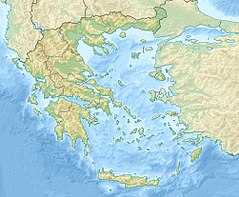Hosios Lukas
 |
|
| UNESCO World Heritage Site | |
|---|---|
| Location | Greece |
| Coordinates | 38°23′41″N 22°44′48″E / 38.39475°N 22.74659°E |
| Criteria | i, iv |
| Reference | 537 |
| Inscription | 1990 (14th Session) |
|
[]
|
|
Hosios Loukas (Greek: Ὅσιος Λουκᾶς) is a historic walled monastery situated near the town of Distomo, in Boeotia, Greece. It is one of the most important monuments of Middle Byzantine architecture and art, and has been listed on UNESCO's World Heritage Sites, along with the monasteries of Nea Moni and Daphnion.
The monastery of Hosios Loukas is situated at a scenic site on the slopes of Mount Helicon. It was founded in the early 10th century AD by the hermit, Venerable (Greek: Hosios) St. Luke (Greek: Lukas), whose relics are kept in the monastery to this day. The hermit (not the Evangelist of the Gospel of Saint Luke, but a hermit who died on 7 February 953) was famous for having predicted the conquest of Crete by Emperor Romanos. It was unclear if he was referring to Romanos I, the emperor at the time. However the island was actually reconquered by Nicephorus Phocas under Romanos II. It is believed that it was during the latter's reign (959-963) that the monastery's Church of the Theotokos (Panagia) was constructed.
The main shrine of the monastery is the tomb of St. Luke, originally situated in the vault, but later placed at the juncture of the two churches. The monastery derived its wealth (including funds required for construction) from the fact that the relics of St. Luke were said to have exuded myron, a sort of perfumed oil which produced healing miracles. Pilgrims hoping for miraculous help were encouraged to sleep by the side of the tomb in order to be healed by incubation. The mosaics around the tomb represent not only St. Luke himself, but also hegumen Philotheos offering a likeness of the newly built church to the saint.
...
Wikipedia

